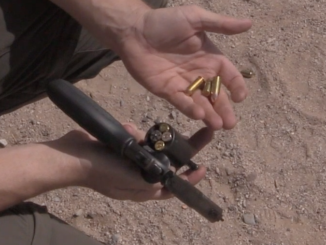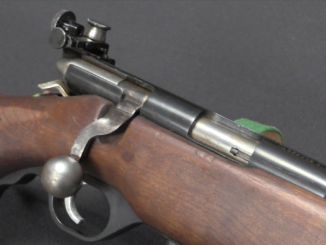When the United States entered World War One, it had a significant shortfall in military handguns. The M1911 pistol production was expanded as much as possible, but more guns were needed. Both Colt and Smith & Wesson adapted revolver designs to Army standard .45 ACP ammunition, and both were accepted into service as the M1917, despite being different guns with no interchangeable parts.
The most interesting mechanical element of the M1917 is the development of half-moon clips to allow easy extraction of the rimless .45 cartridge. The clips were designed by S&W, but also licensed to Colt for use in their M1917 revolvers as well.
The S&W M1917 began as Smith & Wesson’s Triple Lock design, which was simplified a bit (by removing the cylinder crane lock and the barrel lug) and rechambered for .455 Webley to sell to British and Canadian forces before the US entered the war. About 75,000 were sold like this, and it was then rechamberewd again for .45 ACP for US military sales. The first US deliveries were made in October 1917, and about 163,000 were produced by the time production ended in 1919. Only about half of them actually got to the front lines by the end of the war, and many of the guns went into storage. They were actually brought back out and used in significant use in World War Two as well.




I had two model 1917 pistols, a Colt and a S&W. About half-moon clips: they have a significant flaw. Both revolvers use a boss cast into the left side of the frame to retain the cylinder as the ejector rod is pushed. Half-moon clips only clear this boss in two positions where one clip ends and the other begins because the clips grasp the cartridges from the outside. Star clips grasp the cartridges from the inside and never foul this boss and so extract/eject with no drama.
This was one of the reasons for the development of the .45 Auto-Rim cartridge;
https://en.wikipedia.org/wiki/.45_Auto_Rim
One of the odd results was that since the .45 A-R has a thicker and stronger case-head than .45 ACP, it is possible to bring the .45 A-R up to .45 Colt ballistics, which is inadvisable in .45 ACP due to pressure factors;
https://www.buffalobore.com/index.php?l=product_list&c=13
clear ether
eon
If I remember an InRange video correctly, .45 ACP was supposed to mimic the ballistics of the slightly milder .45 Schofield, which fit in the Colt SAA and was preferred by soldiers for actual shooting. Standard US Army loading (unlike the Buffalo Bore listings) is 230-gr FMJ at 850 fps with a chamber pressure of 21,000 psi. Or do you mean not bring .45 ACP up to .45 LC ballistics to shoot from an automatic? I had a friend who reloaded .45 AR to shoot from a shaved Mk VI Webley — it took him a while to figure a load that was both safe and accurate.
The original Army standard load for the Model 1873 .45 revolver was 40 grains of “musket powder” (presumably FFg) behind the 255-grain semi-pointed lead bullet. This resulted in 985 F/S and 550 FPE from the 7.5 in (190mm) barrel of the standard model, often called the “cavalry” model.
It also had a formidable recoil. Which is hardly surprising, as it duplicated the muzzle energy of the 50-grain charge and 220-grain bullet of the older Colt Dragoon percussion revolver in a revolver weighing two-thirds as much.
To alleviate this, the powder charge in the .45 Colt Army cartridge was reduced to 38 grains, which is how the “standard” 255-grain bullet /850 F/S /405 FPE load was created.
This still made it one of the most powerful handguns on Earth at the time. Although the .44-40 WCF 225-grain from a pistol-length barrel was still slightly more powerful (920 F/S and 422 FPE).
Also, contrary to popular belief, the single-shot “horse pistols” the big-bore revolvers replaced weren’t all that powerful. The U.S. Model 1855 .58 pistol carbine, for instance, using a 40-grain charge of musket powder in back of a 468-grain Minie’ bullet, averaged 603 F/S and 378 FPE; about the energy of a modern commercial standard 9 x 19mm 124-grain FMJ.
BTW, that load had previously been standard for the briefly-issued m1854 .58 artillery musketoon. Which massed nearly 1.5X as much as the pistol-carbine. Yes, the pistol carbine was noted for its mule-like “kick”.
see;
Edwards, William B. Civil War Guns. Stackpole, 1962. Chapter 5, pp. 22-24.
cheers
eon
https://naboje.org/node/3822 claims that .45 Auto Rim at some point of history was altered, so its internal volume was increased and thus ballistic improved.
The moon clip added to the case head stren… reth, The stronger bit. Hmm.
Though for practical shooting — war, police, everyday concealed carry — it seems a pain to carry star clips of six compared to half-moons if three. For contests of course, it’s a dream, watch Jerry Miculek reloading.
Has nobody mentioned Brad Pitt carrying a tricked-out 1917 in “Fury”? Was it an S&W or Colt?
https://www.imfdb.org/wiki/Fury_(2014)#Smith_.26_Wesson_M1917 claims it is S&W pointing front sight shape as feature enabling to discern it against Colt Model 1917.
Why would anyone watch “Fury”? Early on a new tank driver tells Brad Pitt he has been in the Army “two weeks.” The whole movie is a damned fantasy
There is also a inspectors cartouche on the grip. Also this revolver and Colt are the reason they invented the 45 Auto Rim cartridge. Basically a rimed 45 Auto.
You might also mention that S&W was so far behind in their production that the government sent in their own techs to remedy the problems and for the first and only time, actually took over production using government people.
The first* moon clip was invented by William John Whiting (for the Webley): Improvements in Quick-loader or Charger Attachments for the Ammunition of Revolver and Magazine Fire-arms, No. 18294 {GB190118294A} 1901. 09. 13.
https://worldwide.espacenet.com/patent/search/family/032151880/publication/GB190118294A?q=pn%3DGB190118294A
Is it known, why Smith&Wesson invented the half moon clip, instead the use of full moon clip?
I guess, the half moon clip is more space-saving, it fits better in pouches.
* P.S.: Sorry Elmer E. Neal.
1. Elmer E. Neal: Loading pack, 881,437. patented Mar. 10, 1908.
https://patentimages.storage.googleapis.com/bf/5c/ad/8eec5ff981135e/US881437.pdf
https://patentimages.storage.googleapis.com/53/54/b7/1504a16c3c5e28/US923068.pdf
2. Elmer E. Neal: Cartridge holder, 923,068, patented May. 25, 1909.
It ought to be mentioned that S&W had routinely cut steps into its chamber walls since about 1870 and the adoption of the non-heeled .44 Russian round (I have read that it was a Russian officer or engineer who suggested it). This was no particular innovation for them in their Model 1917. Early Colt 1917s did not have chamber steps, and were totally dependent on moon clips for headspace, until the gov’t forced S&W to share the step technology.
“(…)non-heeled .44 Russian round (I have read that it was a Russian officer(…)”
According to https://guns.fandom.com/wiki/.44_Russian he was
…Gorloff (who at the time was the military attaché for the Russian Embassy…